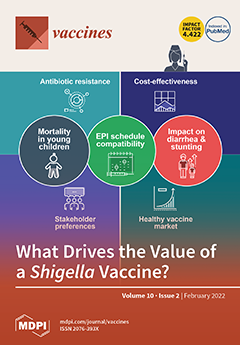Open AccessArticle
Humoral Responses and Chronic GVHD Exacerbation after COVID-19 Vaccination Post Allogeneic Stem Cell Transplantation
by
Caroline Pabst, Louise Benning, Nora Liebers, Maike Janssen, Leandra Caille, Claudius Speer, Lixiazi He, Maria-Luisa Schubert, Laura Simons, Ute Hegenbart, Stefan Schönland, Aleksandar Radujkovic, Michael Schmitt, Paul Schnitzler, Carsten Müller-Tidow, Sascha Dietrich, Peter Dreger and Thomas Luft
Cited by 9 | Viewed by 2074
Abstract
The COVID-19 pandemic threatens patients with a compromised immune and endothelial system, including patients who underwent allogeneic stem cell transplantation (alloSCT). Thus, there is an unmet need for optimizing vaccination management in this high-risk cohort. Here, we monitored antibodies against SARS-CoV-2 spike protein
[...] Read more.
The COVID-19 pandemic threatens patients with a compromised immune and endothelial system, including patients who underwent allogeneic stem cell transplantation (alloSCT). Thus, there is an unmet need for optimizing vaccination management in this high-risk cohort. Here, we monitored antibodies against SARS-CoV-2 spike protein (anti-S1) in 167 vaccinated alloSCT patients. Humoral immune responses were detectable in 81% of patients after two vaccinations with either mRNA-, vector-based, or heterologous regimens. Age, B-cell counts, time interval from vaccination, and the type of vaccine determined antibody titres in patients without systemic immunosuppression (sIS). Similar to a healthy control cohort, mRNA vaccine-based regimens induced higher titres than vector-based vaccines. Patients on two or more immunosuppressants rarely developed immunity. In contrast, 62% and 45% of patients without or on only one immunosuppressant, respectively, showed a strong humoral vaccination response (titre > 100). Exacerbation of cGVHD upon vaccination was observed in 6% of all patients and in 22% of patients receiving immunosuppression for cGVHD. cGVHD exacerbation and low antibody titres were both associated with higher angiopoietin-2 (ANG2) serum levels. In conclusion, mRNA-based vaccines elicit strong humoral responses in alloSCT patients in the absence of double sIS. Biomarkers such as ANG2 might help with weighing cGVHD risk versus beneficial responses.
Full article
►▼
Show Figures






